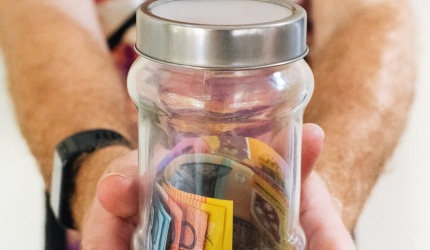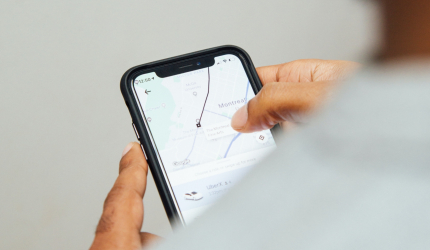Eldorado? Utopic? A catchy title to get you to read my article ? Let’s say a bit of everything, maybe.
Whatever the reason might be as to why you ended up here, here you are now (and we’d like to thank you. Really!).
Who’s the target audience of this article?
So, Mr. Marketer, proud owner of a mobile project or Mr. CEO at the head of a super start-up: You’re here to get your application blasted into the Top-10 in stores. It’s relatively easy if you’ve got the money to do it. But, hey, let’s think of a free way of getting it done.
First deception: there are no miracles. You’ll have your work cut out for you.
Second deception: Just paying an advertising agency isn’t going to get you to the top. Above all, it won’t keep you there.
Now, that’s out of the way, we can get on with what interests us.
Let’s take this article as a prime example. You download an ad just like you ended up reading this article: because the title grabbed your attention, the image was kind of nice and (I hope) your network of friends recommended it to you.
You carry on reading the article because it talks to you. It’s exactly the self-same thing with mobile applications. The number of times the app is downloaded is no longer any sort of criteria for Store owners such as Google and Apple. What counts for them these days is commitment. “Your application must be useful to the world and so it must be used and get feedback from users”. If that feedback turns into passion, then you’ve hit the jackpot and struck it big-time.
Another marketing lesson on positioning?
No. I really don’t feel like it and neither do you. Let’s start from the premise though that you are the CEO of a young and innovative start-up. Or that you are the marketer of a large company that has just come to the conclusion that it’s not enough to get a mobile version of your web page to get your volume of sales up.
In what follows, we shall above all take a look at the best practices that actually work and start from the idea that your project is a unique and never-seen-before experience for the end-user. If that’s not the case, get working on it and then check back with us.
Design Phase
Make it simple.
That’s where things have to start: Back to basics. No kidding. As soon as you open the app, the user needs to know how it works. Don’t bother having long drawn-out forms to sign up. Signing up to an app should be through one or two possible social networks. Nothing more than that. Simple. Even stupidly simple.
Keep the number of screens to a minimum. The mobile user doesn’t like navigating around. On a web desktop it’s easy as you can always hit the back button. Or even use a breadcrumb trail. But, on a mobile device, that sort of button takes up too much space. So, few screens.
Keep navigation simple too. There are many things you can use, but do away with the mouse, hello swipe, press and tap or scroll. Make do with just that.
User Experience
Remember that it’s a mobile experience and there’s a fluctuating bandwidth, minimal resolution and it’s the fingers that are doing the navigating. Oh yes, there’s also the public that you’re targeting in the midst of all of that.
Have a preference for the following:
– A clear interface.
– Minimal architecture that keeps loading of images and constant exchanges with the database to a minimum. Minimize the use of internet or optimize the bandwidth being used.
– A User Interface with buttons that are quite large and think about the lay-out according to the frequency of use (i.e. if your application is going to be used in portrait mode, don’t go putting the key button in the top left-hand corner, please!)
– The Public? Yes, the public. Whenever considering the interface, it’s the public that is the key element and so it must be thought out with them in mind. Of course, I hear you retort: “let’s put in more images for an application for kids”. Obviously. But, remember, for example that a kid hits “Press” far more often than he’ll hit “Tap”. JFYI.
Think SoLoMo.
– Social Local Mobile. Make your application the most social it can possibly be (ideally viral). Let your users share their experience on the social networks they belong to. While you’re at it, track their geographical location. That’ll help you.
– You’ll have to identify the user segments for your application. Think about the KPI that you’d like to use (time spent on your page, navigation from your page, dates, time and geolocalization of the user). From the outset of the design phase think (along with your organization) about where you put trackers and KPI to be sent back.
Say my name?
Heisen… Sorry.
Highly important. Even more so than on the web, the name of your application must be recognized, unique and above all it must work:-). Forget long-sounding names. 2 syllables, maximum that are easy to say. And in English too. The objective is not for users to talk about your app saying something like “XX, the application of ‘Company X’” BUT “It’s XX”. Simple.
If it’s free, You are the product
Going freemium with in-app purchases are extremely successful. On a mobile, it’s all about getting loyalty. Before loyalty though, you need to get them to download it. To get that to happen, the application must gain in visibility in stores. Keep it free. Privilege free downloading. Then, hook your user on your app if you like, but privilege free downloading first.
Keep algorithms of the stores in minds.
At the start, stores take into account the number of times the application is downloaded. So, you’ll have to take into consideration the following points:
– The number of stars: Your app needs to be good and you need to incite the user to note it and above all develop by taking into consideration the remarks and comments being made.
– The number of downloads: Absolutely no secret about that. Get out your best suit out and hit the road talking about your application.
– The time spent using your app: Games are at the top of the list. Make sure you have real added value for the user and keep them on your app (in-app messages, promotions, unlocking more functions). In short, be imaginative.
– The number of times the app is opened: A mobile user opens an average of 8 apps a day. The objective is to be one of those. Use push notifications or mail to keep up contact with your user.
Tweet-Tweet
Set up a profile for your application on Twitter. Not your company profile. Create a simple hashtag on Twitter. Use and abuse to your hearts content.
Set the release date and also when you are going to up-date it
All too often forgotten when it shouldn’t be at all. When do you get the best presents in the year? In December. When you get a new smartphone, it’s normally then that you download the most apps. The start and the end of the year are probably the best times to launch a new app. Up-dates are also very important. For example: The game Fun Run was often up-dated alongside exam dates in American Universities:-).
May I help?
Keep in mind that everything that is digital is evolving at the speed of light. Don’t end up designing your app in the dark recesses of your office. Talk to people around you, bounce ideas of them and take up challenges. Above all, listen to advices!
Eat your own dog food
One last thing: Design apps that YOU would like to use :-).




